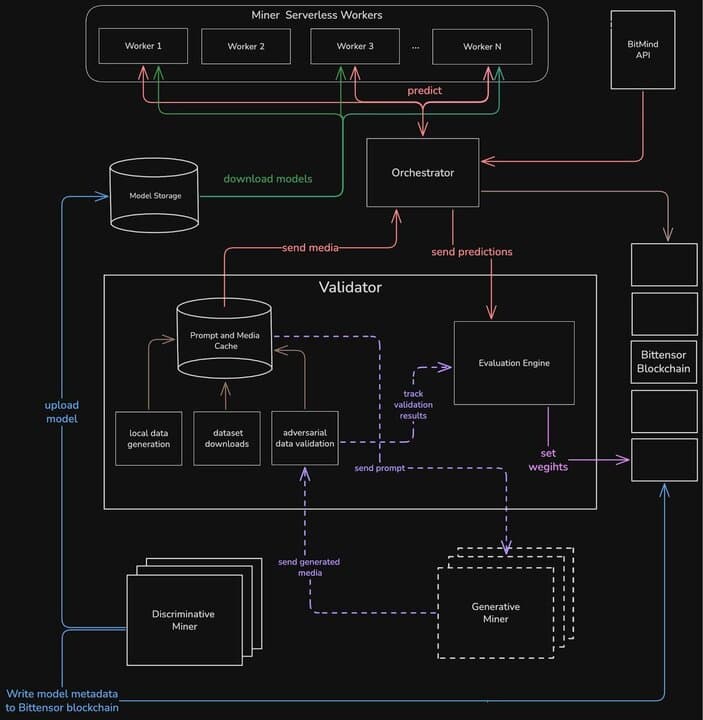Friday, August 15, 2025
Introducing BitMind GAS

The Generative Adversarial Architecture Revolutionizing AI Detection
In today's digital world, fake content, such as deepfakes, synthetic images, and manipulated videos aren't novelties, they're a growing threat. From misinformation campaigns to fraudulent schemes, the ability to create convincing fakes is advancing at breakneck speed. Traditional detection tools often lag behind, relying on outdated data and static methods that can't keep up. We've already developed the most accurate detection models in the world, but now we're taking it to the next level with our latest innovation: GAS (Generative Adversarial System), a significant enhancement for BitMind and a novel Generative Adversarial Architecture design, with the goal to outpace generative AI and deliver even more advanced detection solutions.

What is GAS and Why Does It Matter?
Inspired by Generative Adversarial Networks (GANs), an AI technique where two systems compete to improve each other, GAS turns this concept into a decentralized, incentivized powerhouse. Imagine a never-ending game of cat and mouse: one side creates increasingly realistic fakes, while the other perfects its skills to spot them. This adversarial loop doesn't just detect threats, it evolves the tools in real-time, generating fresh training data to stay ahead and adapt instantly to the pace of new and emerging generative AI models.
For everyday users and businesses, this means reliable protection against synthetic media without the hassle of constant updates or privacy compromises. Unlike rigid, one-size-fits-all AI safety tools, GAS fosters open competition among participants, rewarding innovation and ensuring detectors adapt as fast as the dangers they combat. This new architecture enables near-infinite scaling of our detection services, enables privacy-preserving detection, and provides a massive high fidelity and dynamic dataset generation pipeline that will improve the detection models greatly.

How GAS Works: A Simple Breakdown
At its core, GAS operates on the Bittensor blockchain, where participants collaborate and compete to build superior detection models. Here's how the key players contribute:
Discriminative Miners (Detectors): These are the "detectors." Participants submit AI models that analyze a mix of real and fake media. Rewards are based purely on accuracy, not hardware speed or who registers first. This lowers the entry barrier - no need for expensive servers - while encouraging unique, high-performing models. It's a shift from older systems, focusing on quality over quantity to drive real progress.
Generative Miners (Creators): Coming soon, these "creators" will generate or tweak media based on prompts. Their goal? To create AI images and videos so convincing they fool the detectors. Success here earns rewards, but only if the output passes quality checks to prevent shortcuts. This pushes the boundaries of what's possible, creating diverse, high-quality data for training.
Validators: The referees of the system. They issue challenges, score submissions, and ensure fairness. By mixing generated fakes, real-world samples, and locally created data, validators keep evaluations rigorous and unbiased.
This setup mirrors GANs but supercharges it with Bittensor's decentralized incentives. Miners earn tokens for top performance, creating a vibrant ecosystem where innovation thrives through competition.
The Innovation: GANs Meet Bittensor for Unmatched Detection
What sets GAS apart is its novel fusion of GAN architecture with blockchain-based Generative Adversarial Architecture. GANs have powered breakthroughs in AI creativity (think realistic art or faces generated from scratch), and applying them to a blockchain-based architecture transforms detection. Here's the value propositions:
- Endless Evolution: Static detectors become obsolete quickly. GAS's ongoing rivalry ensures models improve continuously, producing the most accurate classifiers ever, outperforming anything on the market.
- Infinite Scaling: For our enterprise customers, this means handling massive volumes of data without limits.
- Data Superiority: By collecting and training on state-of-the-art (SOTA) generative data, GAS anticipates new fakes before they spread. It's like having a crystal ball for AI risks.
- Privacy Preserving: Miners no longer run detection inference, but rather submit models. This allows us to power our applications on infrastructure where SLAs and privacy preserving guarantees can be met.
In short, GAS represents key value propositions that enable us to grow and scale the business as we enter our revenue expansion phase.
Why This Matters for BitMind and You
As our newest Generative Adversarial Architecture, GAS supercharges our product lineup. Enterprises get unbreakable detection with built-in privacy, developers gain tools to innovate safely, and everyday users enjoy a web where truth wins. We're not just detecting fakes; we're building a future-proof defense.
Ready to dive in? Check out the docs on our GitHub for Discriminative Miners, Validators, and stay tuned for Generative Miners. Explore our applications powered by the Generative Adversarial Architecture at bitmind.ai/product/applications. Join the conversation on X, dive into Bittensor, and let's make the digital world trustworthy again.
Follow us for updates, and subscribe to our Substack for more insights into AI's frontier. Together, we're outsmarting the fakes - one adversarial step at a time. 🚀